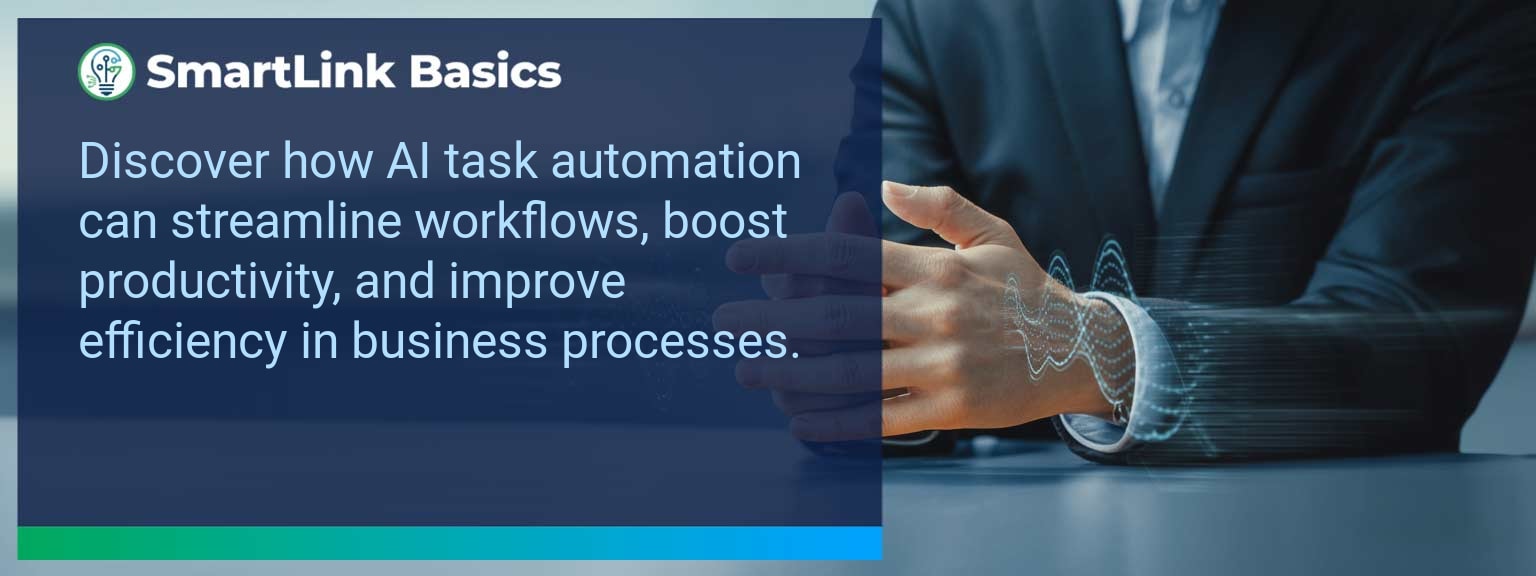Inefficient workflows waste an estimated 26% of the average workday, according to McKinsey research. For sales leaders driving revenue growth, that inefficiency compounds into missed opportunities, delayed deals, and inconsistent customer engagement. At SmartLink Basics, we’ve seen how targeted AI task automation can eliminate repetitive manual steps, integrate data flows, and accelerate decision cycles. In this article, you’ll learn how to identify process bottlenecks, deploy AI solutions into your sales and enablement systems, and measure the gains with precision. You’ll also see where workflow automation aligns with broader digital transformation strategies to deliver sustained productivity improvements.
- Pinpoint workflow bottlenecks that slow high-value activities.
- Integrate AI productivity tools to handle repetitive tasks.
- Streamline system handoffs through intelligent process automation.
- Use measurable KPIs to track efficiency improvements.
- Adopt iterative upgrades to align with future automation innovations.
Identifying Bottlenecks In Current Processes With AI Task Automation
Bottlenecks often occur at the intersections between systems, teams, and data sources. The delays they cause are costly in pipeline velocity and forecast accuracy. AI task automation helps by mapping activity flows and identifying where manual interventions create avoidable lag. For example, a sales team using three separate platforms for lead tracking, proposal creation, and contract management may face multi-day delays in deal progression. Automating the data transfer between these systems reduces cycle time. Leaders should start with a documented workflow map, then analyze which steps can shift from human execution to AI-driven triggers. This creates a prioritized automation roadmap that aligns with revenue objectives.Integrating AI Task Automation Into The Revenue Operating System
A high-functioning revenue operating system requires more than CRM data—it demands synchronized execution across targeting, messaging, and follow-up. AI task automation delivers that by embedding intelligence into each stage. ICP, Segmentation, and Targeting: AI tools can clean and enrich prospect lists, ensuring reps engage the right accounts at the right time. Pipeline Architecture: Automated alerts can flag stalled opportunities or suggest next-best actions based on historical close data. Plays and Messaging: AI productivity tools generate personalized outreach sequences aligned with segment-specific needs. Operating Cadence: Scheduled AI-generated reports keep leadership informed on cycle velocity without manual compilation. Apply these in one business line before scaling. This minimizes risk and builds internal advocacy.Integrating AI Automation For Seamless Operations
Automation reaches its full potential when processes run without disruptive handoffs. AI-powered task orchestration connects dependencies across departments, so sales, marketing, and operations work from the same data stream. A global SaaS firm implemented machine learning automation to align lead scoring, territory routing, and meeting scheduling. The result: a 40% faster lead-to-opportunity conversion rate. The insight for leaders is clear—invest in integrated, intelligent systems that adapt to process changes without requiring heavy retraining.Measurable Gains In Efficiency And Output
Measurement ensures AI deployment delivers real business value. Tracking leading, lagging, and quality metrics verifies that automation is driving the intended improvements, not just reducing workload. Below is a reference table designed for sales leaders integrating workflow automation into business process automation.| Category | Metric | Definition | Target |
|---|---|---|---|
| Leading | Automation Coverage | % of repeatable workflows automated | 70%+ |
| Leading | Data Sync Accuracy | % of records without duplicates or errors after sync | 98%+ |
| Lagging | Average Sales Cycle Time | Days from lead creation to closed deal | -20% from baseline |
| Lagging | Revenue Per Rep | Total revenue divided by active sellers | +15% YoY |
| Quality | Client Engagement Rating | Average client-reported satisfaction with engagement cadence | ≥4.3/5 |
| Quality | Process Reliability Index | Composite score of task completion on time, with accuracy, and without rework | +10% QoQ |
Innovations Shaping The Next Generation Of Automation
Emerging technologies are expanding automation beyond rule-based processing into adaptive, context-aware systems. Developments in process mining, natural language understanding, and predictive analytics allow AI to anticipate workload surges and proactively reassign tasks. For instance, AI systems can soon adjust follow-up frequency based on subtle client engagement signals harvested from multiple channels. This moves automation from reactive to proactive. Sales leaders should monitor these advancements and pilot them within controllable segments, ensuring that the benefits of efficiency improvement outweigh implementation complexity. <Get the 90-day plan, coaching rubric, and dashboard template to operationalize AI in your enablement program.









